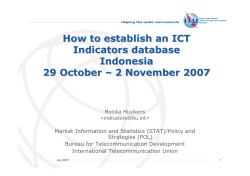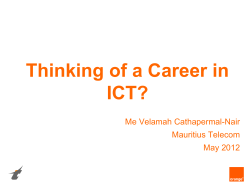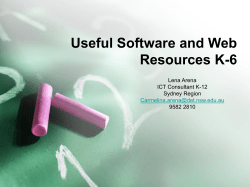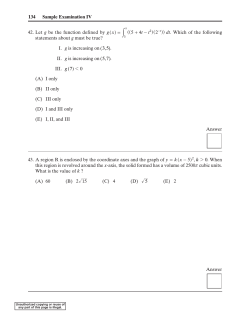
Document 401188
Plenipotentiary Conference (PP-‐14) Busan, 20 October – 7 November 2014 Revision 3 to Document DL/17-‐E 30 October 2014 English only COMMITTEE 5 AHG Note by the Chairman of Committee 5’s Ad hoc Group on Res. 177 and Draft new Res. on Counterfeit Devices COMPILATION OF PROPOSALS FOR A DRAFT NEW RESOLUTION ON COUNTERFEIT DEVICES Please find attached a compilation of the proposals relevant for a draft new Resolution on Counterfeit Devices. Nilo PASQUALI Chairman • www.itu.int/plenipotentiary/ • 2 PP14/DL/17(Rev.3)-‐E DRAFT NEW RESOLUTION [IAP-‐8] Combating counterfeit [and unauthorized] telecommunication/information and communicationICT counterfeit and unauthorized devices The Plenipotentiary Conference of the International Telecommunication Union (Busan, 2014), recalling a) Resolution 177 (GuadalajaraRev. Busan, 2014), of the Plenipotentiary Conference, on conformity and interoperability, which instructs the Director of the Telecommunication Development Bureau to assist Member States in addressing their concerns with respect to counterfeit devices and with the terms of this Resolution; b) Resolution 47 (Rev. Dubai, 2014), of the World Telecommunication Development Conference, on Enhancement of knowledge and effective application of ITU Recommendations in developing countries, including conformance and interoperability testing of systems manufactured on the basis of ITU Recommendations; c) Resolution 79 (Dubai, 2014), of WTDC, on the role of telecommunications/information and communication technologies in combating and dealing with counterfeit telecommunication/information and communication devices; d) Resolution 76 (Rev. Dubai, 2012) of the World Telecommunication Standardization Assembly, recognizing a) the growing problem related to the sale and circulation of counterfeit [and unauthorized] devices in the market, as well as the adverse consequences for users, governments and the private sector; b) that counterfeit [and unauthorized] telecommunication/ICT devices may decrease negatively impact security and quality of service for users and lead to tax losses for governments, among others;[ok] c) that counterfeit [and unauthorized] telecommunication/ICT devices often contain illegal and unacceptable high and illegal levels of hazardous substances, threatening consumers and the environment;[ok] [d) that there are differences between national and international standards applicable to telecommunication/ICT devices,while there are more similarities than differences between counterfeit, and unauthorized telecommunication/ICT devices, it is important to recognize the differences between counterfeit and unauthorized telecommunication/ICT devices which may require different solutions;] e) that some countries have adopted measures to raise awareness of this issue and deployed successful solutions to deter the spreading of counterfeit [and unauthorized] telecommunication/ICT devices, and that developing countries may benefit from learning from those experiences;[ok] f) that some of the solutions measures adopted by the countries rely on unique ICT device identifiers, such as the International Mobile Equipment Identity, to limit and deter counterfeit [and unauthorized] ICT devices;[ok] 3 PP14/DL/17(Rev.3)-‐E [ADD by VEN/88/2 g) that conformity assessment is the accepted way of demonstrating that a product adheres to an international standard and is increasingly important in the context of World Trade Organization (WTO) members' international standardization commitments under the Agreement on Technical Barriers to Trade (TBT),] [moved from draft proposal from VEN on Res 177] g) that industry initiatives have been created to coordinate activity between operators, manufactures, and consumers;[ok] h) that operators ins some countries offer solutions for consumers such as free anti-‐theft applications;[send text to coordinator on mobile theft resolution]; i) that Members States face significant challenges in finding effective solutions to this counterfeit [and unauthorized] devices problem, given the innovative and creative ways used by persons engaged in this illicit activity to evade enforcement/legal measures;[ok] j) the ITU’s Conformity and Interoperability and Bridging Standardization Gap programmes, may are intended to help by bringing clarity to standardization processes and product’s conformity to international standards;[ok] k) that providing interoperability, safety, and reliability should be a key objective of ITU Recommendations,[ok] considering a) that, in general, telecommunication/ICT devices that does do not comply with applicable national conformity processes, as well as national regulatory requirements or other applicable legal requirements, may should be considered unauthorized for sale and/or activation on telecommunications networks of that country; b) that ITU and other relevant stakeholders have key roles to play in fostering coordination between the parties concerned to study the impact of counterfeit and unauthorized devices and the mechanism for limiting their use and to identify ways of dealing with them internationally and regionally, [c) the importance of user connectivity,] aware a) that governments play an important role in combating the manufacture and international trade of counterfeit [and unauthorized] telecommunication/ICT devices by formulating appropriate strategies, policies and legislation; [ok] b) of the current work and studies of ITU Study Groups, in particular of Study Group 11 of the ITU Telecommunication Standardization Sector (ITU-‐T) that is engaged in a study of methodologies and use cases for combating counterfeit and substandard ICT products, and of relevant activities in other relevant forums;[ok] c) that the tampering of unique device identifiers diminishes the effectiveness of solutions adopted by the countries,[ok] d) that there is ongoing to continue working in cooperation with the World Trade Organization and World Intellectual Property Organization on matters related to coordinating activities to combat 4 PP14/DL/17(Rev.3)-‐E counterfeit products and implement an approach aimed at curbing the trafficking of counterfeit products at the international level, [ok] resolves to instructs the Director of the Telecommunication Development Bureau, the Director of the Telecommunication Standardization Bureau and the Director of the Radiocommunication Bureau, 1 to assist Member States in addressing their concerns with respect to counterfeit [and unauthorized] telecommunication/ICT devices by encouraging adoption of mechanisms to combat such practices through information sharing at regional or global level, including conformity assessment systems; ok but brackets 2 to assist all membership in taking the necessary actions to prevent or detect the tampering of unique device identifiers, such as the International Mobile Equipment Identity, interacting with other telecommunication SDOs related to these matters, [ok] invites Member States 1 to take all necessary measures to combat counterfeit [and unauthorized] ICT devices; [ok but with brackets] 2 to cooperate and exchange expertise among themselves in this area; [ok] invites telecommunication operators 1 3to encourage participatione in industry programs combating counterfeit [and unauthorized] telecommunication/ICT devices such as accessing the database for information about stolen devices in each country; [ok] invites all the Membership 1 to participate actively in ITU studies relating to combating counterfeit [and unauthorized] telecommunication/ICT devices by submitting contributions; [ok but with brackets] 2 to take the necessary actions to prevent or detect the tampering of unique ICT devices identifiers, such as the International Mobile Equipment Identity. [ok] CUT&PASTE from PP-‐10 Res 177 [further invites Member States and Sector Members to bear in mind the legal and regulatory frameworks of other countries concerning equipment that negatively affects the quality of their telecommunication infrastructure and services, in particular recognizing the concerns of developing countries with respect to counterfeit and unauthorized ICT equipment.] brackets ______________
© Copyright 2025












